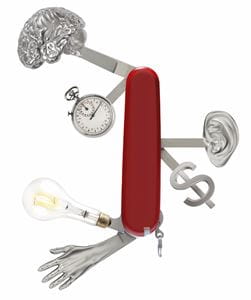Ten top tips for using psychometric tools competently
TeriSmith

When used well, psychometric tools are a powerful output of scientific thought and research, and can be the key to unlocking the potential of an organisation’s most vital but complex asset: its people. But in the wrong hands, or with a misplaced sense of how they can be useful, things can go badly wrong.
So how do you ensure you are commissioning or using tools that will get you kudos for creating lasting improvement, rather than a damp squib that will damage your reputation and that of your business? Here are our ten top tips.
1. Know what you need to achieve
You wouldn’t use a trouser press to wash your car, so ensuring that you’re using the right tool for the job is crucial. Whether you’re making a recruitment decision or aiming to boost the performance of a team or leader, defining exactly what you need to achieve should always be your first step. Then you’re in a position to find the most appropriate solution.
2. Pick the big brands
There are, literally, thousands of personality questionnaires available online – some free, some open-access, some dreamt up, many plagiarised. Unlike some other purchases where the advantages of buying a brand can be subjective, established brands in the psychometrics market can indicate quality. When choosing a psychometric tool, check its credentials in terms of research base and proven efficacy.
3. Share your rationale
When asking someone to complete a psychometric assessment, particularly in the context of development, you will get more buy-in and more valid results if you explain what’s in it for them, rather than simply telling them to take some ‘tests’. Always explain ‘the what and the why’ of an assessment, as well as how to complete it.
4. Maintain confidentiality
It is both unethical and counterproductive to share an individual’s results without their permission. Before asking someone to complete an assessment, you should be clear with them how the results will be used and who they will be shared with. Unless such a ‘contract’ is created and honoured, you will inspire no trust as a user of psychometrics. In fact, many people will proudly share their results if you have fed them back in a meaningful and resonant way.
5. Don’t put people in boxes
Many companies adopt a psychometric instrument of choice and give all their managers the opportunity to complete it as part of a ‘rites of passage’ development process. The advantage of this is huge: people have a language in which to talk about themselves and their differences in a really constructive way. (The MBTI tool works exceptionally well here.) However, be careful that certain ‘types’ are not stigmatised, and that personality is not used as an excuse to neglect certain job requirements (eg ”I don’t do detail”).
6. Train your practitioners
Would you employ a Marketing specialist complete your financial accounts? Neither should anyone deploy psychometrics without appropriate training. Some platforms have been specifically designed to enable the value of psychometric assessment to be available to everyone (eg OPP’s Sirius platform), but to get maximum value from an assessment as well as to access those tools that have been designed to go deeper, additional training is essential.
7. Always offer feedback
The reputation of psychometric assessment generally, and your organisation specifically, can be damaged when you ask people to undertake an assessment, but then give them no feedback. Quality feedback is a crucial way of building your employer brand, particularly in the recruitment sphere where you want even unsuccessful candidates to go away with a positive experience of the process. The authors of the MBTI questionnaire went to some pains to instil the need for people to be given the opportunity to identify their own type, with the best-fit process being integral to determining someone’s profile. This depth of feedback is not essential with other tools, but it can make the process of assessment informative and potentially beneficial, rather than threatening.
8. Apply the ‘so what?’ challenge to get more lasting value
All too often assessments are visited once and the put on the shelf. This is such a shame when the potential to revisit psychometric insights over time provides not only a more in-depth self-understanding, but significant return on the initial investment. In the recruitment space, the results of the selection assessment can also provide excellent insights for onboarding a successful candidate and, subsequently, as the basis for targeted development plans.
9. Encourage sharing
The “you show me yours and I’ll show you mine” approach is a great way to fast-track team development. Whether assembling a new team, moving through a change process or bringing in new blood to an established group, the insights derived from psychometrics accelerate the process of getting to know and trust one another. For senior teams, where substantial egos often collide, they are particularly powerful as they can reveal ‘the man (or woman) behind the mask’ and foster mutual respect. They can also help such groups understand where their homogeneity may restrict their problem-solving or communication style, and flag up their need to involve others with different strengths in some areas of decision-making and execution.
10. Start with yourself
If you have not yet completed a high-quality psychometric instrument and had feedback, consider doing so. For general self-development, you have much to gain – and enjoy – from such an activity. The resonance of what you already know about yourself, combined with the opportunity to think about what you have not yet understood, provide a unique platform for continuous improvement in all areas of your life and skillset, and help you avoid some of the pitfalls that transitions in your life may place in your path.